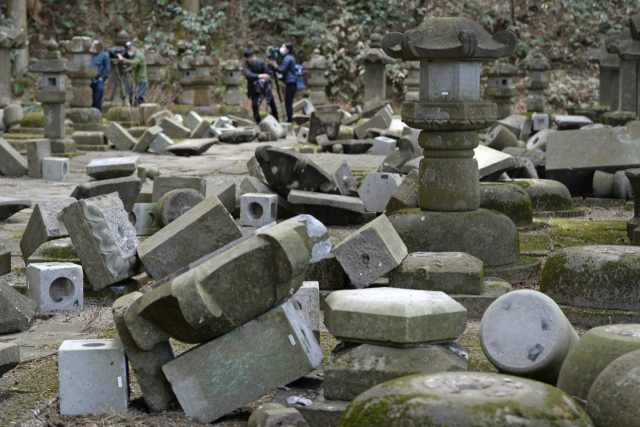It’s been 10 years since the Great East Japan Earthquake… Yeojin is’now and in the future’
Reporter Yoon Yeo-jin [email protected]
Input: 2021-02-16 18:17:06Revision: 2021-02-16 18:21:06Published: 2021-02-16 18:21:38 (p. 12)



Stone lanterns at the entrance to a mausoleum in Sendai, Miyagi Prefecture in northern Japan collapsed and rolled over the road due to the earthquake on the 14th. A 7.3 earthquake occurred in nearby Fukushima Prefecture the night before, injuring over 150 residents of the area. yunhap news
On the night of the 13th, after a strong earthquake of 7.3 on the Richter scale took place off the coast of Fukushima Prefecture, Japan, three aftershocks of magnitude 5 or more occurred in the nearby sea. Japanese authorities, which analyzed it as the aftershock of the Great East Japan Earthquake that occurred in March 2011, made observations that a strong aftershock will continue for a long time.
After the earthquake off Fukushima on the 13th
Three aftershocks of magnitude 5 or more occur
Japan Earthquake Survey Committee “Continued for 10 more years”
According to the Japan Meteorological Agency on the 16th, an earthquake of magnitude 5.3 occurred on the night before 9:26 at 37.5 degrees north latitude and 141.6 degrees east longitude off the coast of Fukushima Prefecture. On the same day, at 3:25 am, an earthquake of magnitude 5.1 occurred at 37.5 degrees north latitude and 142.5 degrees east longitude off the coast of Iwate Prefecture in the north of Fukushima Prefecture. Regarding this, Naoshi Hirata, an emeritus professor at Tokyo University, who is the chairman of the Earthquake Investigation Committee of the Japanese government, said, “The number of aftershocks has decreased 10 years after the Great East Japan Earthquake, but at least I think the current situation will continue for the next 10 years.”
There were 14,647 earthquakes detected over 10 years from the 14th of this month at Yeojin Station, where the aftershocks of the Great East Japan Earthquake occurred, and aftershocks of magnitude 7.0 or larger were 5 times, including the earthquake on the 13th of this month and immediately after the Great East Japan Earthquake. happened.
Seismology believes that aftershocks occur 10 years after an earthquake occurs, as is normal in seismology. Kato Naoyuki, a professor at the University of Tokyo Earthquake Research Institute, said, “The aftershock of the 8.0 Nobi earthquake that occurred in the southern part of Gifu Prefecture in October 1891 continues.”
On the other hand, experts analyzed that the reason that the damage caused by the earthquake on the 13th was relatively small was because the period was short and the epicenter was deep. It was the strongest earthquake since the Great East Japan Earthquake, but as of the 16th, 157 people were injured and no deaths were reported. On the other hand, the similar-scale Kumamoto earthquake that struck Kyushu in April 2016 resulted in 211 deaths and 2746 injuries.
Reporter Yoon Yeo-jin [email protected]·Some Yonhap News
